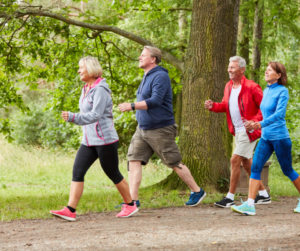How To Maintain Mobility As We Age
 (Always talk with your doctor before beginning any exercise regimen)
(Always talk with your doctor before beginning any exercise regimen)
As you age, it is common to worry about being unable to get around as well as you once did. You might be afraid that you won’t be able to keep up with your favorite activities, go visit your favorite places or even continue doing your everyday tasks. Mobility—the capability to move freely and effortlessly—is essential for maintaining your quality of life and living independently. Changes to mobility naturally occur as you grow older, and you may be wondering how to maintain mobility in old age.
The good news is that by following the tips below, you can maintain and improve senior mobility.
There are various reasons why changes in mobility take place, including changes in how you walk, and your balance, as well as changes to your physical strength. All these changes increase the chance of falling and impact your ability to carry out your normal activities independently. Seniors who fail to maintain their mobility are unlikely to stay living at home; are at a greater risk for disability, disease, hospitalization, and even death; and generally have a lower quality of life.
Without a doubt, the best way to maintain and improve senior mobility is through staying active and practicing mobility skills. Unfortunately, a lot of older adults have trouble engaging in physical activity on a daily basis and spend 9-13 hours sitting each day. This is detrimental to mobility and the longevity of your life. Preserving your mobility doesn’t mean you’re running races. Rather, there are numerous activities you can do to prolong and improve your mobility.
WARM-UP AND COOL DOWN
Warming up and cooling down are an important part of any exercise routine. Before you begin exercising, warm up with some simple stretches to get your body ready for movement. Stretching helps loosen and mobilize your joints, so when you start exercising your body can get more from the movement. Cooling down prevents your muscles from getting stiff after exercise, prevents muscle fatigue, and leads to improved coordination. To cool down, combine the stretches you did with some deep breathing. This will have an overall calming effect on your nervous system, bringing balance to your entire body.
GO FOR A WALK EVERY DAY
Walking is a simple way for you to stay active. It is a low-impact exercise that is great for improving senior mobility, and it has the added benefit of fresh air, which is very good for your mental health. If you feel unsteady while walking and are prone to sometimes losing your balance, start by taking walks around your home and build up to longer walks that you can take outside.
LOW IMPACT CARDIO
Cardio exercise fosters a healthy cardiovascular system. Maintaining a healthy cardiovascular system encourages longevity and mobility. Zumba, kickboxing, and swimming are a few of the ways to help you stay active while having fun while you’re doing it. Senior centers are a great place to get some cardio in through group fitness classes and other activities for seniors to work on their mobility.
STRETCH
As you get older, stretching becomes more important for muscle recovery and mobility. Stretching helps your body maintain flexibility, while also giving your joints a larger range of motion. Stretching regularly helps release the fascia tissue that connects your tendons, muscles, bones, and blood. This keeps the fascia healthy, which then makes it easier for your muscles to glide past one another. When fascia is unhealthy, it gets tight and makes you feel stiff. If you stretch for just 10 minutes each day, your muscles will become more elongated, which in turn allows muscle tension to gradually be released.
WORK ON BALANCE AND COORDINATION
Working on and improving your balance and coordination is pivotal for averting the dangerous falls so many older adults are prone to. A few ways to improve coordination and better your balance include lightweight training, yoga, and Tai chi. Many active seniors have found increased stability through tai chi. Tai chi utilizes slow, deliberate movements that improve range of motion and leg strength, in addition to increasing flexibility and reflexes. When you practice tai chi, you learn how to shift your body weight in a controlled manner that conditions your body to stay upright and maintain stability.
PRACTICE CORRECT POSTURE
It is essential to practice keeping your spine in a neutral posture to maintain mobility and strength. Poor posture is extremely prevalent among seniors, and as a result, makes staying active incredibly difficult. Slouching causes your neck and back muscles to become overworked, progressing to strained shoulders and neck, back pain, and eventually joint damage. Thus, it is important to be cognizant of sitting up straight so that you keep your spine in an upright neutral position.
PROPER NUTRITION
While nutrition may not be as obvious to maintaining mobility as physical activity, it is just as important. Eating a properly balanced diet fuels our bodies, which allows us to stay active. As you age, your body starts to need different nutrients to keep your bones and muscles healthy and strong. Vitamins D and K, calcium, and magnesium are essential for preserving bone density. Omega-3 fatty acids help prevent and reduce muscle and joint discomfort and swelling.
Eating an anti-inflammatory diet is just as important as providing your body with the right nutrients. Inflammation is a common problem faced by older adults, causing joint and muscle stiffness, and even leading to spinal health conditions. In order to keep inflammation at bay and support the integrity of your muscles and joints, eat an anti-inflammatory diet that includes nuts, berries, spinach, and fatty fish. Also, try to stay away from too much sugar, red meat, or fried foods.
